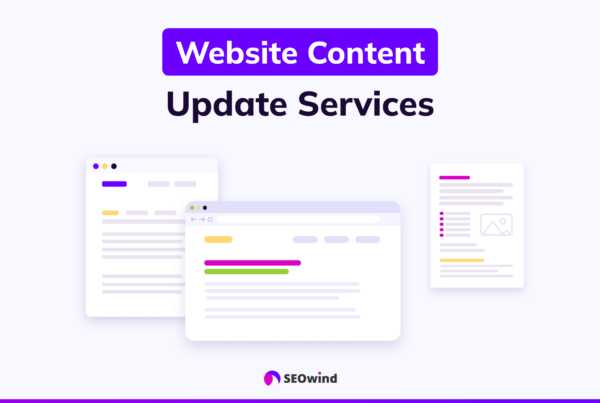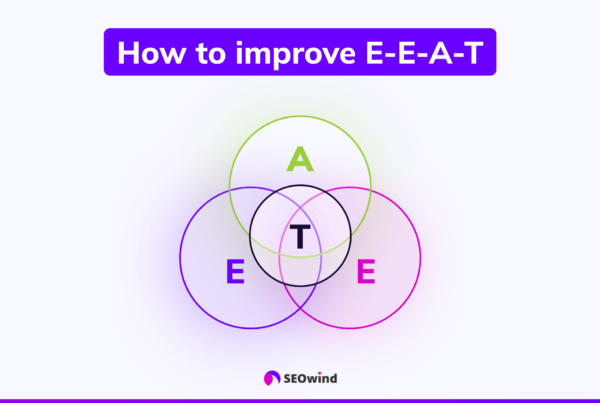Do you need help generating engagement and improving the reach of your blog posts? You’re not alone! Many writers face the challenge of producing great content that stands out in today’s busy online world. Using a blog writing format is one key factor that can make or break your success.
This article explores tips and tricks for creating exceptional articles using a winning blog post formatting strategy! Let’s dive into the art of structuring your masterpiece from listicles, research-backed advice on image use, editing insights, proofreading techniques, and much more.
What is the Blog Writing Format?
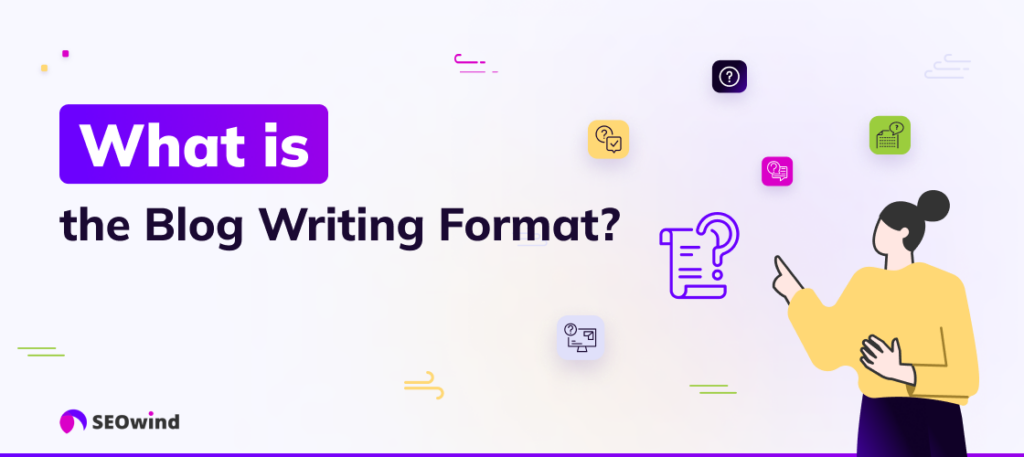
Blog writing format refers to a set structure, style, and layout created specifically for crafting compelling and engaging blog posts. It encompasses everything from page title creation, subheadings usage, and paragraph organization to visual support like images or videos in your post. The primary goal of adopting a consistent blog writing format is to enhance readability, retain reader interest and boost user experience.
A well-thought-out format guides readers through the content. It provides a logical flow that allows them to quickly absorb and understand complex ideas. Moreover, it positively influences search engine optimization (SEO), increasing your visibility in organic search results. By utilizing an effective blog post formatting technique tailored to your specific topic and audience preferences, you can connect better with readers while ensuring they keep returning for more valuable information.
Benefits of Using a Blog Format

Source: Giphy
A consistent and well-formatted blog post provides several advantages for bloggers and their readers. Standard formatting ensures your content is easily accessible, engaging, and valuable to your audience. This section will explore the benefits of using a proper blog post format.
Improved Readability and Clarity
Adopting a clear and consistent blog writing format helps improve your posts’ readability. By structuring your content with headings, subheadings, short paragraphs, bullet points, or numbered lists and breaking up blocks of text with images or other media elements, you make it easier for readers to navigate through complex topics effortlessly.
Enhances User Engagement
When your blog’s writing style is attractive, easy to read, and visually appealing, readers are more likely to engage with the content. They’ll spend more time on your website consuming additional articles, ultimately contributing to increased user engagement metrics such as page views, session duration, and social shares.
Increases Credibility and Trustworthiness
When your blog adheres to a professional writing format consistently throughout all posts, visitors recognize it automatically as an authoritative source of information in the respective field. Your credibility in presenting accurate facts combined with flawless grammar usage fosters trust among readers who continue visiting and recommending your website further.
Encourages Article Shares and Virality
Web users are more inclined towards sharing well-structured articles on their social media platforms or with friends if they find the most enjoyable. An organized layout with an engaging title makes scanning vital information quick while encouraging individuals to share links because they’re confident about its substance.
Better Search Engines Ranking Potential
Following a quality-focused blog writing format increases the chances of reaching higher rankings. It is appreciated not only by readers but also by search engines.
Improved Time Management and Streamlined Writing Process
Adhering to a consistent format for writing blog posts makes it easier to complete your drafts more quickly. With the layout predetermined, you can focus on generating engaging content without worrying about restructuring every new article created for publication. Practicing this streamlined approach saves the effort involved during editing phases while simultaneously churning out a higher volume of quality articles.
What is the Correct Format for Writing a Blog?
The correct format for writing a blog post varies depending on the purpose, audience, and subject matter. However, to create an engaging and accessible article, following some standard formatting guidelines is essential to make your content easily readable and enjoyable.
Here are 10 key components to consider when determining the correct blog format:
- Clear structure: Organize your blog post with an introduction, body text divided into sections using subheadings, and a conclusion. It helps readers quickly grasp your main points while also making navigating through long-form content easier.
- Engaging headlines: Use captivating headlines that pique curiosity and indicate your topic. Be concise and informative, and use relevant keywords that help search engines understand your content.
- Subheadings: Use clear and descriptive subheadings throughout the body of your article. These break up chunks of text into easy-to-read sections and allow readers to skim the content while still understanding the core ideas.
- Short paragraphs: Keep paragraphs between 50-100 words with no more than 15-word sentences – this makes reading more accessible and prevents reader fatigue.
- Lists and bullet points: When appropriate, incorporate ordered or unordered lists within your article, as they can convey information more briefly and efficiently than dense text blocks.
- Visual elements: Add images or other visual aids, such as charts or graphs, that help support your ideas, break up large text areas, or make complex concepts more visually approachable.
- Conversational tone: Balance professionalism with a casual writing style that engages readers without overwhelming them with jargon or excessively complicated language.
- Call-to-action (CTA): Encourage reader interaction by ending each post with a clear CTA that inspires them to share their thoughts or take action, such as subscribing to a newsletter or downloading an offer.
- Internal and external links: Sprinkle relevant internal and external links throughout your post, connecting readers to related articles on your site or linking to credible resources on other websites.
- Optimization for SEO: Ensure your blog is optimized for search engines. Conduct keyword research and incorporate relevant keyword phrases in the article’s title, headings, and content while adhering to best practices regarding keyword density.
By following these guidelines when writing a blog post, you’ll create engaging and informative content that’s easy for readers to understand while establishing yourself as an authority within your industry. These elements can be effortlessly combined with various blog formats such as listicles, how-to articles, comparison/review articles, or guides—thus providing flexibility in structuring posts depending on their specific purpose.
How to Choose the Right Format for Your Blog Post
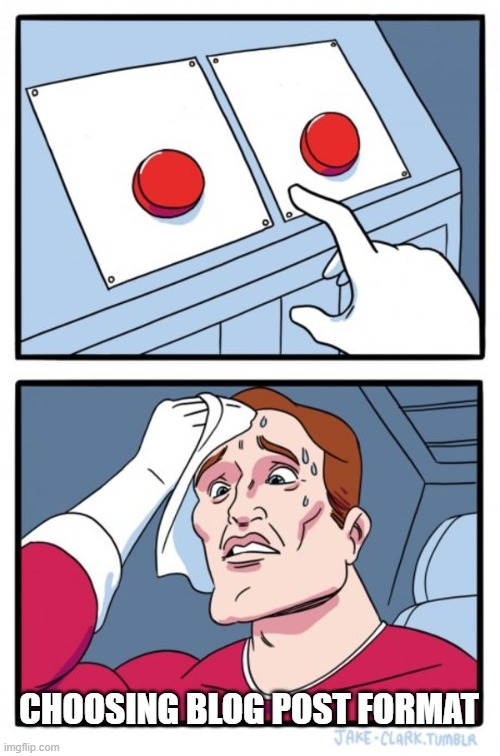

Selecting the ideal blog format is crucial because it can either engage readers or push them away. By understanding your content’s purpose and target audience, you can determine the appropriate structure that best resonates with your readers. Let’s explore four popular blog post formats: listicles, how-to articles, comparison/review articles, and guides.
Listicles
Listicles are among the most engaging and shareable blog post formats. They present information in a simple, organized manner through lists, making complex topics more easily digestible for readers. This format works well when you want to provide a quick overview of ideas or strategies, rank items based on specific criteria, or share several tips on a topic. It is also a practical approach when targeting readers who prefer scanning content rather than reading in-depth articles.
Keep these tips in mind when you start writing listicles:
- Use catchy headlines that highlight the number of points covered.
- Ensure each point provides value to the reader.
- The inclusion of subheadings improves readability.
- Limit the size of your list to avoid overwhelming your reader.
How-To Articles
How-to articles focus on helping readers accomplish a task step by step or learn something new by providing practical, actionable advice and instructions. These articles often address common problems your target audience faces and offer solutions tailored specifically to how readers solve them.
While crafting a compelling how-to article:
- Identify the problem and provide a feasible solution.
- Estimate required resources (e.g., tools and materials).
- Break down instructions into manageable steps using numbered lists or bullet points.
- Supplement text with images or videos where necessary.
Comparison/Review Articles
Comparison/review articles objectively assess products, services, techniques, or trends. They highlight their features, pros, and cons while comparing them against one another as suitable options for consumers looking to make purchasing decisions. To write a high-quality comparison or review article:
- Determine clear criteria for your analysis.
- Be unbiased and transparent in your assessments.
- Include personal experiences, testimonials, or case studies to reinforce the validity of your points.
- Conclude by recommending the best choice based on your analysis.
Guides
Guides dive deeply into topics offering an extensive, comprehensive, and often expert-level understanding of specific subjects. They can be used as ultimate resources for readers looking to achieve mastery within a field or provide in-depth knowledge on a topic. Consider these tips when creating a guide:
- Conduct thorough research to ensure you cover all aspects of the topic.
- Add subheadings that help break down information and enhance readability.
- Use tables of contents; links to specific sections facilitate easy navigation for readers who want to focus on particular parts.
- Update content periodically with current information.
Personal stories and anecdotes: Engaging readers through storytelling techniques
In this era where information floods every corner of our lives, injecting human elements into your content can make it float above monotonous waves.
Consider personal stories or anecdotes – a powerful tool sparking empathetic connections between writers and readers. By fusing aspects of your experiences or observations within the narrative framework, you enrich your message, rendering it vibrant and relatable.
Bear in mind, though – this doesn’t permit rampant rambling. Every anecdote should parallel the central theme seamlessly. If you’re writing about overcoming adversity, a story about finding mold in your breakfast oatmeal might seem offbeat—unless you could skillfully link that mildewy misfortune to resilience.
Interviews and Q&A formats: Conducting interviews or featuring expert opinions in a blog post format
Another popular type of blog post is the ‘Interviews’ or ‘Question & Answer’ (Q&A) format, where insightful conversations with industry experts occur. Imagine tapping into their wisdom – their struggles, successes, and viewpoints – and painting a vivid picture for your audience! These posts hit home for readers eager to learn and understand particular subjects more deeply.
Choosing the right blog post format involves recognizing your audience’s preferences and matching content types accordingly.
Online tools and platforms to assist with blog post formatting


While templates offer guidance on what should be included in each section in your format for a blog post, there are gadgets out there designed specifically to maximize readability and enhance visual appeal:
- Hemingway Editor – Named after Ernest Hemingway, who was notorious for his clear, comprehensive style. The editor will highlight lengthy sentences or complex phrases, making recommendations for improvement.
- Grammarly – An AI-powered tool adept at spotting spelling errors and grammar problems and assessing overall readability.
- Readable.io – This service scores text based on various reading level algorithms, ensuring your content is easily digestible by your target audience.
Take heed; it’s crucial to balance using these aids and retaining your unique voice as a writer. You can enhance your blog post formatting with their assistance while maintaining authenticity.
Tips for optimizing blog posts for SEO through proper formatting
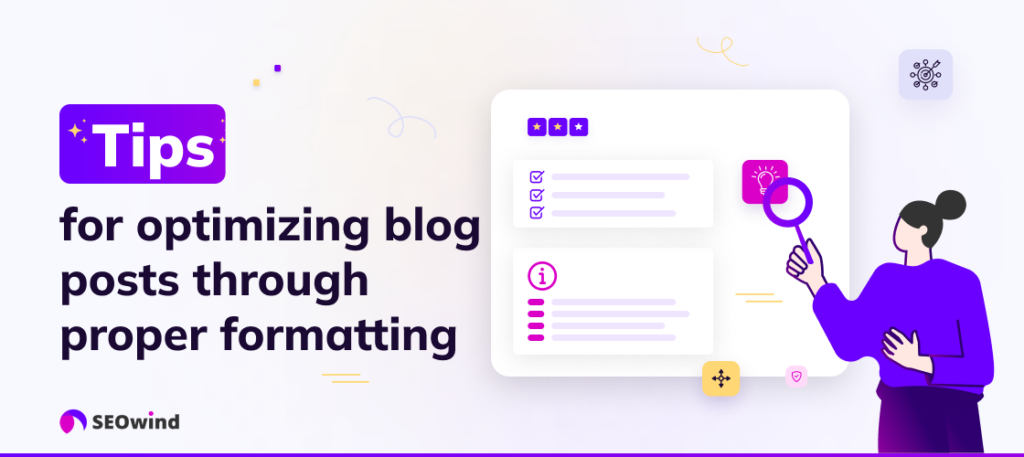

As we delve further into the labyrinth of perfecting your blog post format, let’s turn our attention to making our content shine in the behemoth that is Google’s search engine. And guess what? Your blog formatting helps with this as well! Yes, it is critical in driving organic traffic towards your page. That said, let’s look at some key ways you can optimize your blog posts for improved SEO.
Keyword placement and utilization within headings, subheadings, and content body
We all know keywords hold significant power when used properly; however, did you realize your keyword needs a specific seat on your content train? Indeed, strategic positioning matters greatly.
Your primary keyword – the focal point of your article – should ideally be placed in:
- The title: Does wonders in catching the reader and search engine attention.
- Subheadings: H2 or H3 tags tend to carry more weight with search engines.
- Throughout the text body: Yet remember not to go overboard. Only use natural density, ensuring that readability remains paramount.
The golden rule here? Stick by intent-based keyword optimization – aligning keywords based on volume and user intent too!
Meta tags, title tags, and meta descriptions to enhance search engine visibility
Metadata might seem like unnecessary housekeeping chores lurking behind the scenes. Still, they’ve proven their worth in gold when it comes to getting noticed by Search Engines.
- Title Tags essentially label your online content – Search Engines rely heavily on these guys to understand what each page entails.
- Meta Descriptions give potential visitors an insight into what exists beneath that clickable link – Think of it as those back-cover snippets that determine if a book is worth investing time into.
Remember to incorporate keywords naturally across these fields without disrupting flow or sense.
Optimizing URLs for better search rankings
Lastly, optimizing your URL isn’t simply about aesthetics – it significantly contributes to your blog post style and SEO. When structuring your URL:
- Keep it concise: URLs that are shorter in length tend to perform better on SERPs.
- Use keywords: Include these, but avoid keyword stuffing (a big no-no!).
- Using hyphens to separate words makes the URL easily readable for humans and search engines alike.
Often overlooked, a tidy, well-structured URL can act as an efficient vehicle driving potential viewers straight to your blog’s doorstep!
Thus, by focusing on these elements, you enhance user experience, and Google is bound to reward you with improved rankings – a double win indeed!
Mistakes to Avoid in Blog Post Formatting


Source: Giphy
In our journey to perfect the blog writing format, identifying pitfalls is equally as crucial as learning best practices. Hence, this section seeks to teach you about common mistakes bloggers often make during their formatting process and how to avoid them actively.
Overcrowding Content with Excessive Styling or Visual Elements
The adage “Less is More” holds even regarding blog post style. While adding visual elements and styling options such as boldface, italics, underlining, flashy colors, and heavy graphics may seem like a great way to emphasize critical points and break monotony, overdoing these can be counterproductive.
When you overcrowd your content with too much styling or numerous visuals, your readers may struggle to focus on the actual content, making it challenging for them to identify key points within your message. The overall look of the post becomes chaotic rather than appealing.
To uphold an engaging yet straightforward blog writing format:
- Use visual elements sparingly: Graphics should enhance comprehension, not distract from it.
- Stick to simple text styling: Bold and italicize keywords if necessary, but avoid too many bright colors and fancy fonts, which might detract from readability.
Neglecting to Proofread and Edit for Grammar and Spelling Errors
Even the most beautifully formatted blog post can be marred by spelling mistakes or grammatical errors. These errors harm your credibility as they give off an impression of carelessness. Readers are less likely to trust or return to a site that cannot maintain a high standard of language accuracy.
Commitment towards eliminating such missteps involves:
- Thorough proofreading after writing: Read aloud where possible for better error detection.
- Utilizing grammar-checking tools like Grammarly.
- Hiring professional editing services if within budget constraints.
Remember, perfection lies in details!
Failing to Use Header Tags Properly for SEO Optimization
Heading tags are not just for improving readability but also play an integral role in SEO optimization. Yet, often, this element is incorrectly used or completely overlooked, leading to missed opportunities to enhance blog visibility on search engines.
Improper use of header tags confuses the hierarchical structure that search engine crawlers use for understanding content and determining its relevance to a user’s query.
Effectively utilizing header tags involves:
- Consistent usage: Stick to one header tag (H1) for your title
- Sequential order: Follow the logical order with subheadings – H2 followed by H3 and so forth.
- Strategically placing keywords: Sprinkle relevant keywords within your headings without compromising natural sentence flow.
Veering off these common pitfalls ensures your blog writing format remains reader-friendly while maximizing SEO potential. Keep them in mind as you tackle each post, striving relentlessly for betterment.
Best Practices for Formatting Blog Posts for Mobile Devices
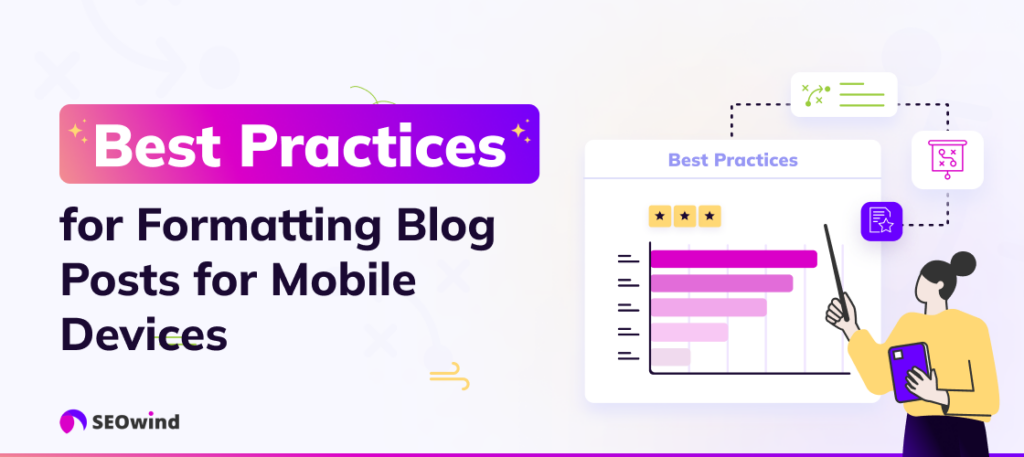

As we delve deeper into a predominantly mobile-driven online landscape, optimizing your blog for mobile devices becomes more critical than ever. Hence, keeping mobile target audiences in mind while shaping your blog content can significantly enhance reader engagement and accessibility.
Responsive Design and Mobile-Friendly Layouts
The crux of delivering an engaging reading experience on handheld devices lies in adopting responsive design. A responsive layout seamlessly adjusts to the screen size without hampering readability or forcing unnecessary scrolling or resizing by the user. Using a responsive HTML builder can simplify this process, enabling you to create layouts that automatically adapt to various devices while maintaining a polished and user-friendly appearance.
- Prioritize simplicity: Keep your blog layout clean and minimalistic for easy navigation.
- Adapt responsiveness automatically: Ensure that columns, images, menus, and text beautifully adapt to the device, whether it’s a phone or tablet.
- Emphasize legibility: Maintain suitable font sizes that are neither overwhelmingly large nor too small to read comfortably.
When designing for mobile-first using the appropriate blog writing format, remember there’s limited space to work with. Therefore, each element should serve its purpose — enhancing readability while offering visually pleasing aesthetics without cluttering up the space.
Tips for Optimizing Images and Media For Mobile Screens
Images and media elements tend to be attention catchers within any form of written content – if correctly used in relation to device screens.
- Compress images before uploading them onto your blog post so as not to compromise site speed.
- Opt for SVG (Scalable Vector Graphics) over PNGs or JPEGs whenever possible, as they scale better.
- Utilize HTML5 videos instead of embedded ones to facilitate faster load times.
Be cautious in applying media formats that might disrupt the coherent flow of reading on smaller screens – these include pop-ups or intrusive ads that cover part of your content.
Font Selection and Legibility on Smaller Screens
A carefully chosen font can significantly impact how readers perceive your content. On smaller screens, it’s crucial to choose a typeface that enhances the readability of your blog posts.
Try sticking with sans-serif fonts such as Open Sans or Roboto, which generally display better on digital screens. Fonts sizing between 14-16 points ensures a comfortable reading experience without forcing the reader to zoom into every single line of text.
Line spacing too plays a part – aim for at least 1.5x in terms of spacing ratio to allow easy visual navigation from one line to the next.
As a final note, remember ‘white space’ is well-placed silence in blog formatting. It not only offers rest points for eyes but also breaks the monotony of continuous text blocks.
In conclusion, appropriately tailoring your blog writing format for mobile audiences isn’t just about increased accessibility; it’s about conveying respect towards your readers and their chosen modes of interaction with your content.
Creating an Engaging Title For Your Blog Post


Creating an engaging title for your blog post is critical to attracting readers and maintaining their interest. A compelling headline captures the essence of your content and entices your target audience to click through and read more. Here are some tips on crafting the perfect title for your blog post.
Keep it Concise and Relevant
A compelling blog post title should be concise yet informative enough to provide an accurate idea of what the content contains. Ensure you stay true to the subject matter by incorporating relevant keywords into the title – ideally within 60 characters or less. Remember, search engines will truncate longer titles, making them difficult to read and less likely to receive clicks.
Use Numbers and Action Words
Incorporate numbers in your headlines when applicable, as studies have shown that they perform better than other types of headlines. Additionally, aim for action words that draw readers’ attention and evoke urgency or curiosity in readers. Phrases such as “discover,” “reveal,” or “learn” can intrigue readers and prompt them to engage with your content.
Target Reader Emotions
Tap into human emotions when crafting your headline by connecting with the reader’s aspirations or desires. For example, a blog post, “7 Ways to Boost Your Confidence Today” appeals directly to those looking for self-improvement techniques for achieving confidence goals.
Solve a Problem or Answer a Question
Addressing specific problems your readers face can make your blog format more valuable. Demonstrate how reading this blog post will help resolve a particular issue or answer questions about it – like: “How To Choose The Perfect Color Palette For Your Website.”
Test Multiple Headlines
Feel free to experiment with different headlines before settling on one. Brainstorm multiple variations of potential titles and test them using tools like CoSchedule’s Headline Analyzer or share drafts among colleagues for feedback.
By following these tips, you can craft engaging titles that showcase the value of your content and entice readers to click through. By doing so, you contribute to creating a successful blog post format capable of capturing attention and driving traffic toward your website.
Write a Content Outline For Your Post
Before diving into writing your very first blog post, create a content outline that will guide you through the process. An outline helps organize your thoughts and ensure that your content flows seamlessly from one point to another. Outlining allows you to tackle complex topics more efficiently and provides a roadmap for how to structure your post effectively.
Establish Heading Depth
One of the critical aspects to consider while outlining your new blog post is establishing heading depth. Proper use of headings not only enhances readability but also improves the overall presentation of your blog post format. Here are some tips for structuring headings appropriately:
- Use H1 for your main title, which should include your primary keyword.
- Follow a consistent hierarchy with H2 for main sections and H3 for sub-sections.
- Ensure each heading is informative, relevant, and concise – ideally using 5-9 words.
- Include relevant keywords within subheadings whenever possible without any compromise on readability.
By adhering to these principles, readers can quickly scan through your post and locate the exact information they want.
Add Table of Contents
For longer blog posts or guides, adding a table of contents improves navigation and allows readers to jump directly to specific sections they’re interested in.
Here’s how you can create a practical table of contents:
- List out all the headings and subheadings established during the outlining process.
- Organize them hierarchically under relevant categories (if applicable).
- Assign hyperlinks to each item on the list directing them to corresponding sections within the article.
- Place the table at the beginning of the blog post, right after the introduction.
A well-crafted table of contents creates an excellent user experience by making it easy for readers to find precisely what they need within a large body of content.
Write Engaging Introductions and Conclusions
Introductions and conclusions play a vital role in the blog format. While introductions hook readers from the start, conclusions provide closure and may encourage further engagement with your content.
Engaging Introductions
Here are some tips for creating captivating introductions:
- Start with an attention-grabbing statement, anecdote, or question.
- Provide a brief overview of what the reader can expect from the post.
- Make sure to include your target keyword within the first 100 words.
- Maintain a conversational tone that resonates with your target audience.
An engaging introduction will set the stage for your entire blog post and motivate readers to continue through its entirety.
Impactful Conclusions
When crafting an impactful conclusion, keep these points in mind:
- Summarize the key takeaways covered throughout your blog post.
- Restate how this information adds value to or solves problems for readers.
- Encourage reader action by adding a clear call-to-action (CTA) or suggesting relevant posts for additional reading.
- Leave room for comments or questions from readers, inviting them to interact with you.
By implementing these techniques when writing introductions and conclusions, you’ll increase reader engagement significantly while improving your blog’s overall format.
Doing Research and Checking Facts


Source: Giphy
A crucial aspect of writing high-quality blog posts is conducting thorough research and checking the facts you plan to include in your blog article. With an abundance of information available on the internet, establishing yourself as a credible source becomes more challenging than ever. In this section, we will discuss the process of doing accurate research and verifying facts for your blog articles.
Properly Conduct Research
To maintain trustworthiness among your readers while ensuring quality content, follow these guidelines:
- Utilize multiple reliable sources: Obtain information from various reputable sources like academic journals, industry-specific websites, professional organizations, or governmental publications.
- Cross-check your data: Confirm facts by comparing them with similar findings or statements made by established experts in the field.
- Keep track of where you found each piece of information: Note down all sources used during your research so that you can easily reference them later if required.
Verify Facts
After gathering relevant data for your blog articles, it’s essential to verify those facts to ensure their accuracy:
- Double-check primary sources: Adequately analyze primary sources such as interviews, patents, or legal documents related to the topic.
- Fact-check statistics: Ensure that any figures or percentages included in your article are accurate and up-to-date by double-checking them using reliable third-party resources like Statista or World Bank Open Data.
- Verify quotes and claims: When quoting someone else’s words or sharing their ideas in your blog post, precisely what you’re writing matches the original statement.
As language plays an essential role in conveying complex topics effectively into simple terms for beginners, consider using some of our keywords like “blog post formatting,” “format of writing a blog,” and “how to format a blog” in natural ways throughout this section.
Proper research and fact-checking form the foundation for valuable, trustworthy blog content. By doing in-depth research and verifying the accuracy of your facts, you better the chances of establishing yourself as an authoritative voice within your niche, thereby generating increased reader engagement and conversions.
Using Images Effectively


A picture is worth a thousand words – this adage also holds in the world of blog writing. Incorporating relevant and high-quality images can make all the difference when crafting a compelling blog post. Let’s discuss why using images effectively can enhance your blog post formatting.
Images Help Your Blog Post Flow More Effectively
Visually breaking up your text with captivating images can significantly improve the overall flow of your blog post. The presence of engaging visuals offers relief to the eyes and creates breathing space for readers amidst blocks of text. It ensures that readers don’t become overwhelmed or lose interest in your content due to large chunks of uninterrupted text.
Some ways to use images for improved flow include:
- Inserting a relevant image after every few paragraphs
- Combining multiple related points into an infographic
- Including screenshots or examples to provide clarification
Remember, choosing visuals that align with your content and support the message you’re conveying is essential.
Images Make Great Visual Punchlines
Incorporating images strategically throughout your piece will capture and maintain reader interest and serve as visual punchlines. These are memorable moments that create impact, highlight key takeaways, or add humor when appropriate.
To achieve this effect:
- Place images closely after strong statements or conclusions.
- Use visual metaphors that illustrate a point creatively.
- Utilize design elements such as graphs, charts, or illustrated quotes.
Adding well-thought-out visual punchlines to your blog posts leave lasting impressions on readers and makes your content stand out from others in the industry.
Images Make Complex Topics More Easily Understandable
When explaining intricate subjects or sharing complex data in articles about industry trends and research findings, using visuals like infographics, graphs, or charts proves highly beneficial. Presenting information visually rather than only through text makes complicated ideas digestible and captivating for your audience.
Some guidelines to adhere to when integrating images:
- Ensure image quality: Use high-resolution visuals so readers can see details.
- Use accurate labeling: Descriptive labels, legends, or captions will aid in understanding the contextual significance of each visual element.
- Maintain consistency: Present information uniformly throughout your blog post format. For example, use similar designs and color schemes or stick to a particular illustration style.
Images make your blog post formatting more engaging by enhancing flow, creating visual punchlines, and rendering complex topics more comprehensible. If used effectively and strategically within the context of your content, they can transform your overall writing experience – and elevate the impact it leaves on readers.
The Editing Tips for Your Blog Post
Once you have completed your draft, the editing process is crucial to ensure your new blog post is engaging and easy to understand. This section will discuss some useful tips for editing your work.
Avoid Repetition
Repetition can make your writing feel tedious and monotonous. Try using synonyms or rephrasing sentences to keep your readers engaged when discussing similar ideas. This also prevents keyword stuffing, which search engines may penalize.
- Use a thesaurus while editing
- Look for repetitive structures or phrases
- Replace words with a more appropriate alternative wherever possible
Read Your Post Out Loud to Check Flow
Reading your post aloud can help identify sentence structure and flow issues that might not be apparent when only reading silently. Listening to the rhythm of your writing can pinpoint awkward phrasing or sentences that are too long. As you read out loud:
- Ensure smooth transitions between blog post ideas and topics
- Adjust any sentences that sound unnatural or confusing
- Make sure your tone remains consistent throughout the text
Have Someone Else Read Your Work
A fresh pair of eyes can often notice mistakes or inconsistencies that you might overlook after spending significant time working on a piece. Asking someone else to review your blog post allows for an unbiased perspective on readability and clarity.
- Choose someone knowledgeable about the topic if possible
- Request they provide constructive feedback and specific examples of things they think need improvement
- Discuss their thoughts and suggestions before making changes
Keep Sentences Short and Paragraphs Shorter
Long sentences can be difficult for readers to follow. In contrast, short paragraphs allow for easy skimming – an important element in online reading habits. It’s essential to balance providing detailed information and maintaining reader engagement.
- Aim for an average sentence length of 15 words or fewer
- Limit paragraphs to around 50–100 words
- Break complex ideas into smaller, more digestible pieces
Accept That Your Blog Post Will Never Be Perfect
As a content writer, striving for perfection can lead to endless rewrites and unnecessary stress. Recognize that even the best articles will have room for improvement, and focus on refining your work to the best of your ability within a reasonable timeframe.
- Set yourself a deadline for editing
- Do multiple editing passes, focusing on different aspects each time (e.g., grammar, flow)
- Remind yourself that you can always revise later if needed
Don’t Be Afraid to Make Cuts or Adjust
Sometimes, sections of your blog post may not be as relevant or valuable as initially thought. Removing any unnecessary content or tangents that might detract from the main message is crucial.
- Question whether each paragraph adds value to the overall piece
- Be open to changing course if new information emerges during editing
- Consider restructuring if it enhances readability and comprehension
15 Formatting Tips for a Compelling Blog Post


1. Focus on the Reader
When formatting your blog post, always prioritize the needs and preferences of your target audience. Ensure your blog post format is engaging and easy to digest by creating a logical flow between sections and subheadings. By doing so, you’ll help readers better understand complex topics and maintain their interest throughout the article.
2. Hook the Readers with the Headline
An eye-catching headline is crucial in attracting readers to your piece. Spend time crafting a compelling, informative title that accurately represents the content. Use powerful language and key terms relevant to your topic to attract attention and pique curiosity.
3. Use Proper Subheadings
Break down your content into sections with clear subheadings. This will make it easier for readers to follow along and focus on specific discussion points. Additionally, adequately formatted subheadings improve SEO – search engines use them to understand your content hierarchy and display pertinent information in search results.
4. Be Coherent
Always keep coherence in mind when structuring your blog post. Ensure each section logically follows from one point to another without abrupt transitions or inconsistent pacing. Maintaining a coherent narrative will give a polished impression that keeps readers interested and engaged.
5. Use Short, Simple, Direct Sentences
Simple sentences are more accessible than lengthy passages with jargon or complicated phrasing. Construct sentences using straightforward language—aiming for 15 words or fewer per sentence—and active voice whenever possible to enhance readability.
6. Use Short Paragraphs
Adhere to the principle of brevity by keeping your paragraphs short and concise—between 50-100 words each—to convey ideas effectively while maintaining reader interest throughout your article.
7. Use Lists and Bullet Points
Lists offer an organized visual representation of information that can help break up chunks of text into more digestible portions for readers.
- Unordered lists work well when presenting multiple facts or examples.
- Ordered lists help outline step-by-step processes or prioritize factors.
8. Use Bold Fonts Wisely
Bold fonts can emphasize essential points within your content, making them more visible and easily identifiable. However, use bold sparingly to avoid overwhelming readers and diluting the potency of your key messages.
9. Use Blockquotes When Needed
Blockquotes come in handy when quoting notable experts or referencing important research findings. They help differentiate quoted material from the rest of the text while adding credibility to your blog post. Make sure you attribute your sources appropriately for added authenticity.
10. Choose Images to Grab Attention
Visual elements like images can significantly enhance reader engagement and understanding by providing visual cues that complement the written content. Bear in mind these principles when incorporating images:
- Relevance: Select images related to your topic.
- High-quality: Opt for clear, visually appealing graphics.
- Copyright compliance: Abide by licensing requirements if necessary.
11. Add More Rich Media and Visuals
Incorporating relevant visuals such as images, videos, infographics, and gifs into your blog post can make a difference in reader engagement. These compelling elements not only support your written content but also add variation that keeps your reader engrossed:
- Use high-quality images or graphics that complement the topic.
- Embed relevant YouTube videos or social media posts.
- Include helpful infographics to illustrate complex data or concepts.
Adding visual elements breaks monotony while keeping readers engaged and informed enjoyably.
12. Use Alt Tags in Images
Including alt tags (image descriptions) ensures web accessibility. It enhances your blog’s SEO performance by describing the contents of an image for search engines’ indexing purposes.
13. Use the BLUF Approach
The ‘Bottom Line Up Front’ (BLUF) approach ensures that readers grasp the purpose of your post right away. Presenting them with a clear message at the onset helps retain their interest. Here’s how you can follow the BLUF approach:
- Come up with an informative headline that states the main idea or benefit.
- Write a concise introduction as outlined previously.
- Utilize subheadings to divide your content into easily digestible sections.
- Summarize the major points in each section using bullet points or ordered lists.
This approach will allow busy readers to grasp your message and absorb information quickly.
14. Create Lots of White Spaces
An underrated aspect of efficacious blog writing format is handling white spaces appropriately — which involves breaking down long blocks of text into smaller chunks. By incorporating shorter paragraphs (typically 50-100 words), you enhance readability by making it easier on the eyes.
Bear in mind these additional tips when crafting paragraphs:
- Vary paragraph lengths for better visual flow.
- Use headers, lists, or quotes to break up text.
Don’t underestimate the impact of strategic white space placement on your readers’ experience and overall content quality.
15. Add Links to Other Relevant Content
Cross-linking is crucial — it showcases additional resources on related subjects. It boosts search engine rankings for your present article and those linked within. When implementing this tactic:
- Only link to highly relevant articles.
- Concentrate on internal links (pointing to other sections of your website).
- Use natural anchor text that blends seamlessly with your writing style and vocabulary.
By integrating insightful cross-links throughout your post, you’ll optimize the user experience through easy navigation while encouraging further exploration of your blog’s offerings.
Optimize for Conversion and Add Clear CTAs
One of the primary goals of creating a blog post should be to optimize it for conversion, ensuring that your content effectively leads readers towards taking a desired action. This action can vary depending on the purpose of your blog, such as signing up for a newsletter, purchasing a product, or learning more about a service. Include clear calls-to-action (CTAs) strategically throughout your content.
Position CTAs Wisely
Positioning your CTAs at key points within your blog post will dramatically increase their effectiveness. Often CTAs are added in the following places:
- The beginning or end of a section presents an opportunity for the reader to take action.
- In the middle of long posts where the reader might need encouragement to continue reading.
- Somewhere within several paragraphs with high engagement rates.
- In visually prominent places like image captions or block quotes.
Remember not to clutter your content with too many CTAs – choose wisely and keep them relevant.
Choose Your CTA Text Carefully
The text used in your call-to-action is essential in engaging readers and encouraging them to complete the targeted action. Some best practices include:
- Keeping it brief: Aim for no more than 5 words.
- Use persuasive language: Use verbs like “discover,” “learn,” or “join” rather than generic phrases such as “click here.”
- Make it personal: Address your readers using words like “you” and “your.”
Tailor Your CTA Design to Your Target Audience
A well-designed CTA button can significantly impact its effectiveness when driving users toward specific actions. To create compelling buttons, consider these tips:
- Contrast colors between text and background to make buttons pop out from surrounding content.
- Carefully select typography that reflects your brand’s tone while staying legible on small screens if needed.
- Opt for rounded corners, which are easier on the eyes and evoke a friendlier vibe.
Track CTA Performance
Finally, understanding how well your CTAs perform is crucial to optimizing them further. Monitor key metrics such as click-through rate (CTR) and conversion rate using tools like Google Analytics or heat-mapping software. With this information, you can refine your blog format and CTA placement, ensuring that your posts drive meaningful results over time.
By giving due attention to optimizing conversions within your blog post formatting strategy, you can guide readers from browsing through engaging content toward taking clear and intentional actions. This process makes your content marketing and blogging efforts worthwhile while driving business growth and success.
Proofreading Tips For Your Blog Post


Proofreading your blog post is a crucial step in writing, ensuring that your content is accurate, engaging, and error-free. A well-proofread blog post demonstrates professionalism and integrity, allowing you to foster trust with your audience.
This section will discuss some of the essential tips for proofreading your blog post effectively.
Check Grammar and Spelling Errors
- Use online grammar-checking tools: Platforms such as Grammarly or Hemingway Editor are excellent resources for identifying grammatical mistakes and spelling errors. These tools also offer suggestions for improving sentence structure and readability.
- Read your work slowly: Reading your content aloud will help you catch any errors that slipped past during the writing process. You might find missing words, awkward phrasing, or repetitive sentences while reading aloud.
- Pay attention to homophones: Homophones are words that sound similar but have different meanings and spellings (e.g., “there,” “they’re,” and “there”). Ensure that you’ve chosen the correct word in each context.
- Look for commonly confused words: Certain words tend to be mixed up often, such as “effect” vs. “affect” or “lose” vs. “loose.” Always double-check these tricky terms to ensure they make sense within their respective contexts.
- Be mindful of punctuation errors: Punctuation is essential in clarifying meaning; incorrect usage can confuse readers. Look for missing commas, misplaced apostrophes, or other inconsistencies.
By incorporating these proofreading tips into your editing routine, you’ll ensure that every blog content aligns with proper standards for clean and professional-grade writing — setting up both you and your blog for continued success!

